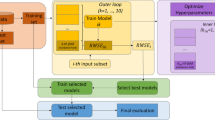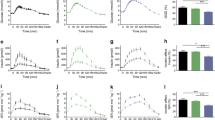Abstract
Aims
Insulin resistance underlies the etiology of both type 2 diabetes and gestational diabetes. In pregnancy, insulin resistance is also associated with an unfavorable metabolic programming of the fetus, potentially contributing to a higher risk of obesity and type 2 diabetes in the offspring. To assess insulin sensitivity, several methods based on glucose and insulin levels during a 75-g oral glucose tolerance test (OGTT) exist. It is unclear how they perform during pregnancy, where physiologically altered metabolism could introduce a bias.
Methods
In a cohort comprising 476 non-diabetic subjects undergoing OGTT and hyperinsulinemic-euglycemic clamp (HEC), we used cross-validation to develop an insulin sensitivity index also based on non-esterified fatty acids (NEFA) that could be more robust during pregnancy (NEFA-index). We tested commonly used OGTT-based indexes and the NEFA-index in a different cohort of 42 women during pregnancy and 1 year after delivery.
Results
The Matsuda and OGIS index failed to detect lower insulin sensitivity during pregnancy as compared to the follow-up OGTT 1 year after delivery (p > 0.09). The new NEFA-index incorporating BMI, plasma insulin and NEFA, but not glucose, clearly indicated lower insulin sensitivity during pregnancy (p < 0.0001). In the non-pregnant cohort, this NEFA-index correlated well with the gold-standard HEC-based insulin sensitivity index, and outperformed other tested indexes for the prediction of HEC-measured insulin resistance.
Conclusions
This insulin/NEFA-based approach is feasible, robust, and could be consistently used to estimate insulin sensitivity also during pregnancy.


Similar content being viewed by others
References
Linder K, Schleger F, Ketterer C et al (2014) Maternal insulin sensitivity is associated with oral glucose-induced changes in fetal brain activity. Diabetologia 57:1192–1198. doi:10.1007/s00125-014-3217-9
Bergman RN, Finegood DT, Ader M (1985) Assessment of insulin sensitivity in vivo. Endocr Rev 6:45–86. doi:10.1210/edrv-6-1-45
Bergman RN, Prager R, Volund A, Olefsky JM (1987) Equivalence of the insulin sensitivity index in man derived by the minimal model method and the euglycemic glucose clamp. J Clin Invest 79:790–800
Otten J, Ahrén B, Olsson T (2014) Surrogate measures of insulin sensitivity versus the hyperinsulinaemic–euglycaemic clamp: a meta-analysis. Diabetologia 57:1781–1788. doi:10.1007/s00125-014-3285-x
Stanley K, Fraser R, Bruce C (1998) Physiological changes in insulin resistance in human pregnancy: longitudinal study with the hyperinsulinaemic euglycaemic clamp technique. Br J Obstet Gynaecol 105:756–759
Homko C, Sivan E, Chen X et al (2001) Insulin secretion during and after pregnancy in patients with gestational diabetes mellitus. J Clin Endocrinol Metabol 86:568–573. doi:10.1210/jcem.86.2.7137
Noctor E, Crowe C, Carmody LA et al (2015) ATLANTIC-DIP: prevalence of metabolic syndrome and insulin resistance in women with previous gestational diabetes mellitus by International Association of Diabetes in Pregnancy Study Groups criteria. Acta Diabetol 52:153–160. doi:10.1007/s00592-014-0621-z
de Seymour JV, Conlon CA, Sulek K et al (2014) Early pregnancy metabolite profiling discovers a potential biomarker for the subsequent development of gestational diabetes mellitus. Acta Diabetol 51:887–890. doi:10.1007/s00592-014-0626-7
Rasanen JP, Snyder CK, Rao PV et al (2013) Glycosylated fibronectin as a first-trimester biomarker for prediction of gestational diabetes. Obstet Gynecol 122:586–594. doi:10.1097/AOG.0b013e3182a0c88b
Lehmann R, Friedrich T, Krebiehl G et al (2015) Metabolic profiles during an oral glucose tolerance test in pregnant women with and without gestational diabetes. Exp Clin Endocrinol Diabetes 123:483–438. doi:10.1055/s-0035-1549887
Göbl CS, Bozkurt L, Yarragudi R et al (2014) Is early postpartum HbA1c an appropriate risk predictor after pregnancy with gestational diabetes mellitus? Acta Diabetol 51:715–722. doi:10.1007/s00592-014-0574-2
Di Cianni G, Miccoli R, Volpe L et al (2003) Intermediate metabolism in normal pregnancy and in gestational diabetes. Diabetes Metabol Res Rev 19:259–270. doi:10.1002/dmrr.390
Groop LC, Bonadonna RC, DelPrato S et al (1989) Glucose and free fatty acid metabolism in non-insulin-dependent diabetes mellitus. Evidence for multiple sites of insulin resistance. J Clin Invest 84:205–213. doi:10.1172/JCI114142
Stefan N, Fritsche A, Häring H, Stumvoll M (2001) Effect of experimental elevation of free fatty acids on insulin secretion and insulin sensitivity in healthy carriers of the Pro12Ala polymorphism of the peroxisome proliferator–activated receptor-γ2 Gene. Diabetes 50:1143–1148. doi:10.2337/diabetes.50.5.1143
Boden G (2011) Obesity, insulin resistance and free fatty acids. Curr Opin Endocrinol Diabetes Obes. doi:10.1097/MED.0b013e3283444b09
Stumvoll M, Tschritter O, Fritsche A et al (2002) Association of the T–G polymorphism in adiponectin (exon 2) with obesity and insulin sensitivity: interaction with family history of type 2 diabetes. Diabetes 51:37–41
Groop L, Forsblom C, Lehtovirta M et al (1996) Metabolic consequences of a family history of NIDDM (the Botnia study): evidence for sex-specific parental effects. Diabetes 45:1585–1593
Tripathy D, Wessman Y, Gullström M et al (2003) Importance of obtaining independent measures of insulin secretion and insulin sensitivity during the same test: results with the Botnia clamp. Diabetes Care 26:1395–1401
Hastie T, Tibshirani R, Friedman J (2009) The elements of statistical learning: data mining, inference, and prediction, 2nd edn. Springer Science & Business Media, Berlin
James G, Witten D, Hastie T, Tibshirani R (2015) An introduction to statistical learning. Springer, Berlin
DeLong ER, DeLong DM, Clarke-Pearson DL (1988) Comparing the areas under two or more correlated receiver operating characteristic curves: a nonparametric approach. Biometrics 44:837–845
R Core Team (2015) R: a language and environment for statistical computing. R Foundation for Statistical Computing, Vienna
Mari A, Pacini G, Murphy E et al (2001) A model-based method for assessing insulin sensitivity from the oral glucose tolerance test. Diabetes Care 24:539–548
Matsuda M, DeFronzo RA (1999) Insulin sensitivity indices obtained from oral glucose tolerance testing: comparison with the euglycemic insulin clamp. Diabetes Care 22:1462–1470
Butte NF (2000) Carbohydrate and lipid metabolism in pregnancy: normal compared with gestational diabetes mellitus. Am J Clin Nutr 71:1256S–1261S
Belfiore F, Iannello S, Volpicelli G (1998) Insulin sensitivity indices calculated from basal and OGTT-induced insulin, glucose, and FFA levels. Mol Genet Metabol 63:134–141. doi:10.1006/mgme.1997.2658
Perseghin G, Caumo A, Caloni M et al (2001) Incorporation of the fasting plasma FFA concentration into QUICKI improves its association with insulin sensitivity in nonobese individuals. J Clin Endocrinol Metabol 86:4776–4781. doi:10.1210/jcem.86.10.7902
Abdul-Ghani MA, Molina-Carrion M, Jani R et al (2008) Adipocytes in subjects with impaired fasting glucose and impaired glucose tolerance are resistant to the anti-lipolytic effect of insulin. Acta Diabetol 45:147–150. doi:10.1007/s00592-008-0033-z
Hadden DR, McLaughlin C (2009) Normal and abnormal maternal metabolism during pregnancy. Semin Fetal Neonatal Med 14:66–71. doi:10.1016/j.siny.2008.09.004
Sivan E, Chen X, Homko CJ et al (1997) Longitudinal study of carbohydrate metabolism in healthy obese pregnant women. Diabetes Care 20:1470–1475
Zambon A, Hashimoto SI, Brunzell JD (1993) Analysis of techniques to obtain plasma for measurement of levels of free fatty acids. J Lipid Res 34:1021–1028
Menéndez LG, Fernández AL, Enguix A et al (2001) Effect of storage of plasma and serum on enzymatic determination of non-esterified fatty acids. Ann Clin Biochem 38:252–255
Acknowledgments
We thank all the research volunteers for their participation. We gratefully acknowledge the excellent technical assistance of Anja Dessecker, Ellen Kollmar and Andreas Vosseler, all Department of Internal Medicine, Division of Endocrinology, Diabetology, Nephrology, Vascular Disease and Clinical Chemistry, University Hospital, Eberhard Karls University, Tübingen.
Author contributions
R.W and L.F. analyzed data and wrote the manuscript. E.F., N.S., H.S, H-U. H, M.H contributed to discussion and edited the manuscript, A.F. contributed to discussion and wrote the manuscript.
Author information
Authors and Affiliations
Corresponding author
Ethics declarations
Conflict of interest
The authors declare that they have no conflict of interest.
Ethical standard
The studies were approved by the local institutional review board.
Human and animal rights disclosure
All procedures followed were in accordance with the ethical standards of the responsible committee on human experimentation (institutional and national) and with the Helsinki Declaration of 1975, as revised in 2008.
Informed consent
Informed consent was obtained from all patients for being included in the study.
Additional information
Managed by Antonio Secchi.
Robert Wagner and Louise Fritsche have contributed equally to this work.
An erratum to this article is available at http://dx.doi.org/10.1007/s00592-017-1002-1.
Electronic supplementary material
Below is the link to the electronic supplementary material.
Rights and permissions
About this article
Cite this article
Wagner, R., Fritsche, L., Heni, M. et al. A novel insulin sensitivity index particularly suitable to measure insulin sensitivity during gestation. Acta Diabetol 53, 1037–1044 (2016). https://doi.org/10.1007/s00592-016-0930-5
Received:
Accepted:
Published:
Issue Date:
DOI: https://doi.org/10.1007/s00592-016-0930-5




